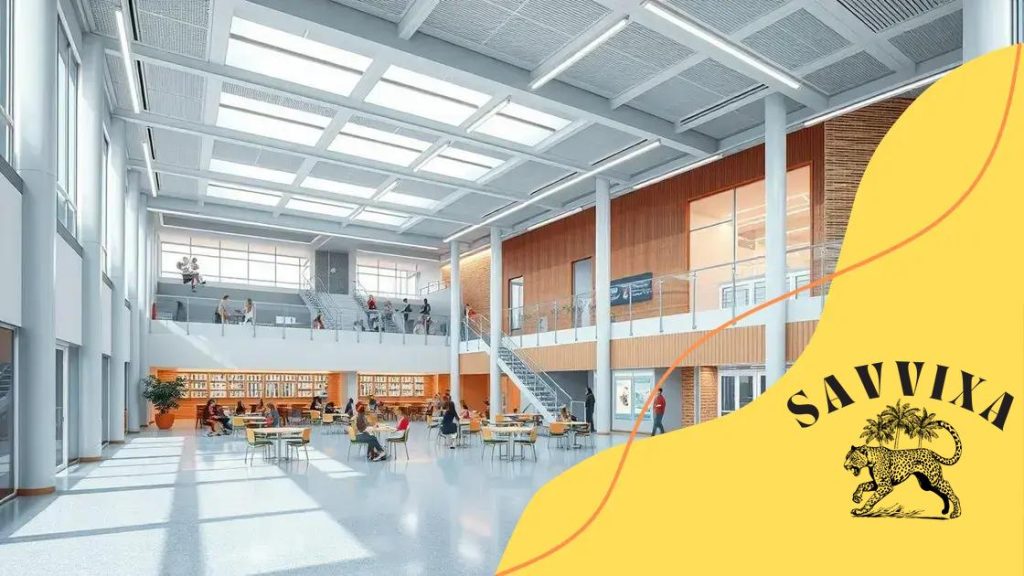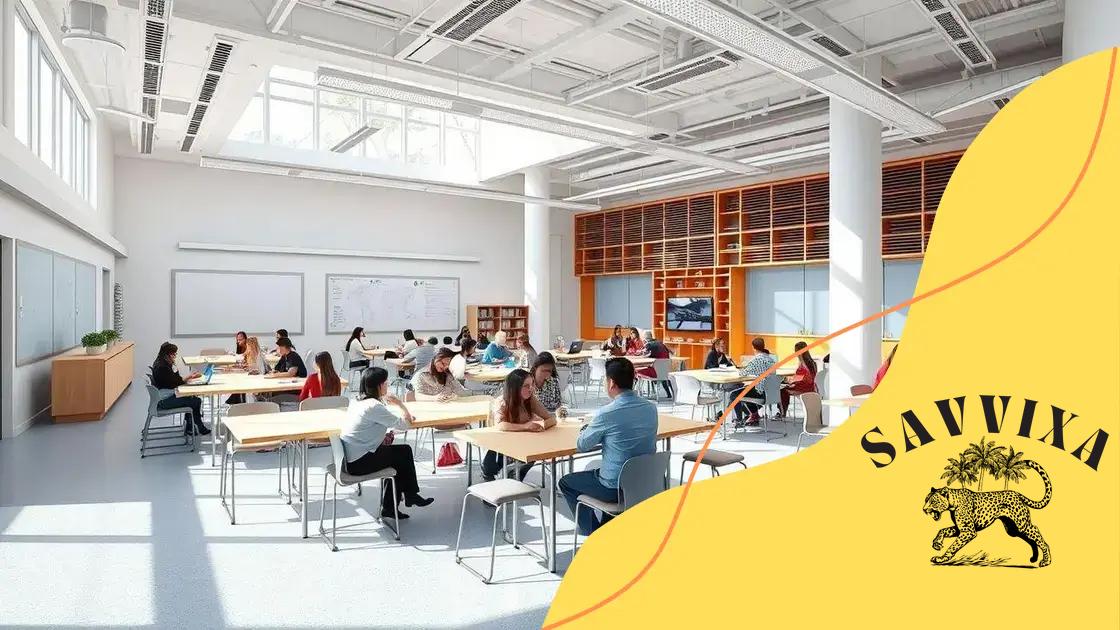Influence of good structures in schools on student success

The influence of good structures in schools directly enhances student engagement and learning outcomes through effective classroom designs, technology integration, and collaborative spaces.
The influence of good structures in schools plays a vital role in shaping the educational experience. Have you ever thought about how the layout and resources of a school affect learning outcomes? This article explores the profound impacts of physical environments on student achievement.
Understanding the importance of school structures
Understanding the importance of school structures is essential for creating effective learning environments. Schools are more than just buildings; they are spaces where students grow, learn, and engage with their peers and teachers. By examining how these structures influence education, we can better appreciate their value.
Key Elements of Effective School Structures
Several key elements contribute to the effectiveness of school structures. These elements can directly impact student learning and overall school performance. They include:
- Facility layout: A well-organized layout promotes ease of movement and access to resources.
- Resource availability: Ample resources such as libraries and labs enhance the learning experience.
- Collaborative spaces: Areas designed for group work facilitate teamwork and creative thinking.
- Technology integration: Incorporating technology in classrooms supports diverse learning styles and needs.
Each of these elements plays a significant role in shaping the educational experience. For instance, when students have access to updated technology, they can better engage with the material. A well-designed classroom layout can encourage participation and interaction among students.
Impact on Student Engagement
The structures of schools greatly influence student engagement. Environments that are inviting and stimulating can motivate students to participate actively in their learning. For example, classrooms filled with natural light can improve focus and energy levels.
Additionally, incorporating art displays and student work within the school enhances the sense of ownership and belonging. When students feel connected to their environment, they are more likely to invest in their education.
Ultimately, understanding the importance of school structures leads to better planning and investment in educational facilities. When designed thoughtfully, these structures can create a positive impact on student achievement and well-being.
How good facilities enhance learning
How good facilities enhance learning is a vital concept in education. Quality facilities provide a foundation that supports effective teaching and learning. When students are in well-equipped environments, they are more likely to thrive academically.
The Role of Technology
Up-to-date technology in schools can significantly affect student outcomes. Access to computers, tablets, and smartboards helps students interact with the material in engaging ways. This access allows them to:
- Explore new subjects through interactive tools.
- Conduct research easily and efficiently.
- Collaborate with classmates on projects using digital platforms.
- Enhance their learning through diverse methods.
With technology, students develop valuable skills that they will need in the future.
Comfort and Design
The physical design of a school plays a crucial role in student comfort and learning. Classrooms that are bright and spacious can improve focus and mood. Comfortable furniture allows students to concentrate without distractions. Elements such as proper ventilation and lighting can also enhance the learning experience.
Furthermore, schools with designated areas for relaxing and socializing can help students build relationships and reduce stress. These aspects create a positive school culture that encourages learning and open communication among peers.
Good facilities serve another important purpose: safety. Schools designed with safety in mind help protect students and reduce anxiety, allowing them to focus on their studies. When students feel safe and secure in their environment, they are more likely to engage in the learning process.
The role of classroom design in engagement

The role of classroom design in engagement is critical for facilitating active learning. When classrooms are designed thoughtfully, they can significantly enhance student participation and enthusiasm for learning.
Flexible Seating Arrangements
Utilizing flexible seating arrangements allows students to choose how and where they want to learn. This approach encourages collaboration and communication among peers.
- Students can work together in groups.
- They can choose quiet spaces for individual focus.
- The variety in seating helps maintain energy and attention.
- It’s vital for accommodating different learning styles.
With flexibility, students feel more empowered to take charge of their learning experiences.
Incorporating Natural Elements
Incorporating natural elements into classroom design, such as plants and natural light, can boost student motivation. Exposure to natural light has been shown to improve mood and concentration. When students feel more comfortable and connected to their environment, they engage more deeply with their studies.
Additionally, using colors that stimulate creativity and calm can help enhance focus. Classrooms designed with these elements promote a positive atmosphere that invites participation.
A well-designed classroom should also include spaces for discussion and collaboration. By integrating areas for group work, students can feel more at ease sharing ideas and processes. This layout fosters a community feeling and encourages engagement among students.
Collaboration spaces and their impact
Collaboration spaces and their impact on learning are significant in today’s educational environment. These areas foster teamwork, critical thinking, and communication among students, which are essential skills for success.
Encouraging Group Work
Collaboration spaces are designed to encourage group work. When students gather in these areas, they can share ideas and perspectives. This interaction helps enhance their understanding of the material. Collaborative projects allow students to:
- Learn from one another’s strengths.
- Improve problem-solving skills.
- Build confidence in their abilities.
- Enhance their creativity through diverse viewpoints.
These outcomes make collaboration spaces vital to the learning process.
Creating a Sense of Community
Collaboration spaces also create a sense of community within the school. When students work together, they form friendships and develop trust. This connection can lead to a more inclusive school environment where all voices are heard.
Moreover, the design of these spaces can foster interaction. For example, open layouts and comfortable seating arrangements encourage students to engage with one another easily. Comfortable furniture can make students feel more at ease, promoting cooperation.
When students feel like they belong, they are likely to remain engaged and motivated in their studies. Additionally, collaboration spaces can be beneficial beyond the classroom. They can serve as hubs for extracurricular activities, allowing students to connect over common interests.
Case studies of schools with effective structures
Case studies of schools with effective structures illustrate how positive changes in facilities can lead to improved student outcomes. These real-world examples show the significant impact that thoughtful design and resources can have on education.
Example 1: Innovative Classroom Designs
One school district in California transformed traditional classrooms into flexible learning environments. By removing rigid desks and introducing movable furniture, students can now collaborate more freely.
- The new layout enhances student engagement.
- Teachers can easily rearrange spaces for different activities.
- Students reported enjoying their classes more due to the inviting atmosphere.
This shift in classroom design has resulted in higher test scores and improved attendance rates.
Example 2: Integrating Technology
A school in Texas prioritized adding technology resources to its classrooms. With interactive whiteboards, tablets, and access to online learning resources, students have been able to enhance their learning experiences.
Students are more excited about lessons that utilize technology. They can:
- Engage in interactive lessons that spark interest.
- Collaborate on projects using digital tools.
- Access information instantly, promoting independent learning.
This integration of technology has led to a noticeable increase in academic performance, with students obtaining higher grades across subjects.
Through these case studies, we see that effective structures directly contribute to enhanced educational experiences. Schools that invest in their facilities create nurturing environments where students can thrive.
In conclusion, the impact of good structures in schools is undeniable. Schools that invest in their facilities create effective environments that enhance students’ learning experiences. From flexible classroom designs to integrating technology, these elements significantly improve engagement and achievement. When we see positive case studies, it becomes clear that thoughtful planning can lead to success for both students and educators. By prioritizing good structures, we pave the way for a brighter educational future.
\n\n\n
\n
\n
FAQ – Frequently Asked Questions about the Influence of Good Structures in Schools
How do good structures improve student learning?
Good structures enhance the learning environment, making it more engaging and effective for students.
What role does classroom design play in engagement?
Classroom design influences student engagement by encouraging collaboration and interaction among students.
How can technology integration benefit schools?
Integrating technology makes learning more interactive and helps students access resources quickly.
What are some successful examples of schools with effective structures?
Many schools have seen positive outcomes by implementing flexible designs and tech resources, leading to improved student performance.